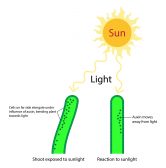Definition
noun
(biochemistry) The polysaccharide unit of proteoglycan
Supplement
Glycosaminoglycans are the polysaccharide components of proteoglycans. They are polymers of acidic disaccharides containing derivatives of the amino sugars glucosamine or galactosamine. They are found primarily on cell surfaces and in the extracellular matrix. They are polar molecules and therefore attract water. They serve as a lubricant or as a shock absorber in the body, such as in the joints. They are also involved in cell migration in a way that their rigid structure provides a passageway between cells.
Hyaluronate is an example of glycosaminoglycans. They are found in the synovial fluid, articular cartilage, vitreous humor, etc. They are large polymers and are efficient as the body’s shock absorber. Another glycosaminoglycan is chondroitin sulfate. The latter is found in the cartilage, bone, and heart valves. It is regarded as the most abundant glycosaminoglycan. It is sulfated and composed of alternating sugars, N-acetylgalactosamine and glucuronic acid. Heparan sulfate is also a glycosaminoglycan. It occurs in the basement membranes and on the surfaces of the cell. It may bind to various protein ligands and regulates different biological activities, e.g. angiogenesis and blood coagulation. Heparin is a glycosaminoglycan component of intracellular granules of mast cells. They are also found in the linings of the arteries of the lungs, liver, and skin.1
Abbreviation: GAG
Also called:
- mucopolysaccharide
See also:
Reference(s):
1 Glycosaminoglycans. Retrieved from ://themedicalbiochemistrypage.org/glycans.php.







